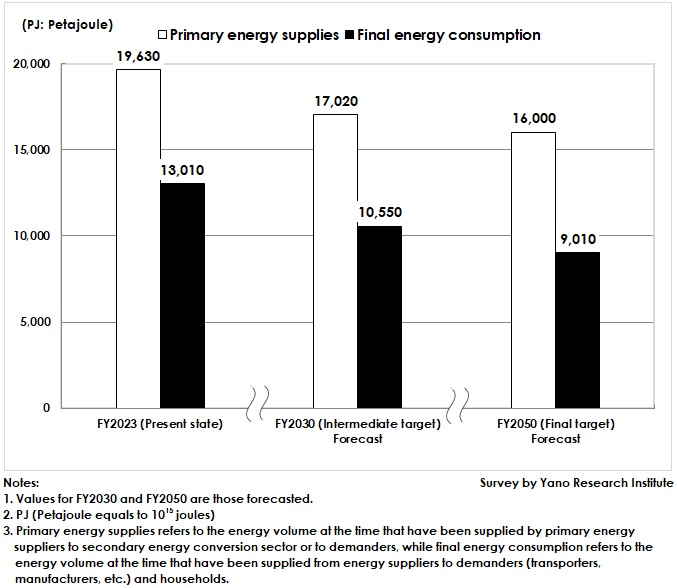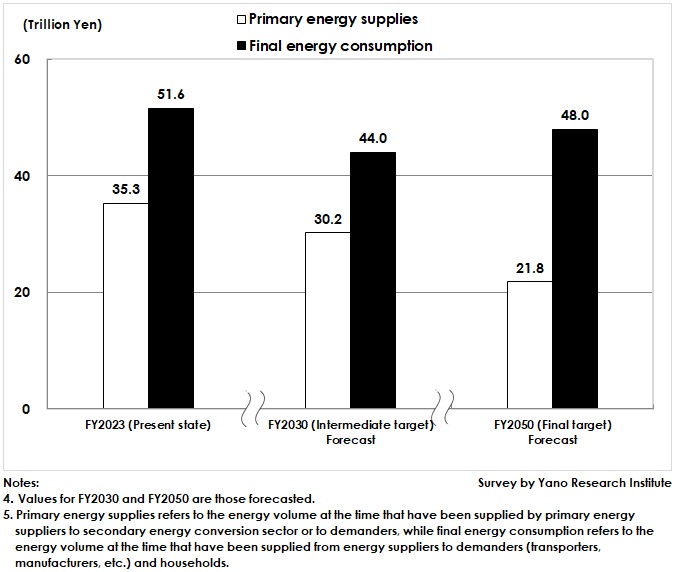No.3394
Efforts to Transform Energy Flows for Achieving Carbon Neutrality in Japan: Key Research Findings 2023
Final Energy Consumption Market Size in Japan Projected to Decline from 13,010 PJ or 51.6 Trillion Yen in FY2023 to 9,010 PJ or 48.0 Trillion Yen by FY2050
Yano Research Institute (the President, Takashi Mizukoshi) surveyed and analyzed the status of reforms in the energy balance and flows in Japan in FY2030 (for mid-term target) and in FY2050 (the final target). This paper covers the forecast for the energy supply business market size by energy volume and value.


Market Overview
To achieve carbon neutrality by 2050, Japan is required for energy decarbonization. Currently, primary energy (the energy sources harvested directly from natural resources) without CO2 emissions is nuclear power and renewable energy, which are needed to expand adoption to realize carbon neutrality.
In contrast, if fossil fuels are used, CO2 emitted from industrial processes such as steel and cement production or from the burning of fossil fuels in power generation should be captured and be stored deep underground (i.e., Carbon dioxide Capture and Storage, CCS), or to be reused (i.e., Carbon dioxide Capture and Utilization), thereby to decarbonize (i.e., Carbon dioxide Capture, Utilization and Storage, or CCUS).
Meanwhile, there are potential new decarbonized energy, such as green hydrogen and green ammonia that are produced by using renewable energy, and blue hydrogen and blue ammonia that are produced by decarbonizing fossil fuels. In addition, green hydrogen and blue hydrogen have a potential to produce synthetic fuels or synthetic materials through decarbonization processes.
For achieving carbon neutrality, Japan aims to use the above-mentioned carbon neutral fuels (decarbonized fuels) and electricity generated from such fuel sources. If electricity generated from decarbonized fuels can be applied at final energy demanders, it is possible to decarbonize many demand sectors.
Toward carbon neutrality, the domestic energy balance flow (primary energy, secondary energy, and final energy consumption) will be dramatically transformed, as hydrogen, ammonia, synthetic fuels, etc. are included to existing energy sources.
Noteworthy Topics
Together with energy saving measures, as applications of carbon neutral fuels (decarbonized fuels) and electricity generated from such fuel sources are expected to increase for achieving carbon neutrality by 2050, the domestic primary energy supply market size (by energy volume) is projected to decline from 19,630 PJ* in FY2023 to 17,020 PJ by FY2030 and 16,000 PJ by FY2050. The market size by value is also likely to decline from 35.3 trillion yen in FY2023 to 30.2 trillion yen by FY2030 and 21.8 trillion yen by FY2050. Steady energy saving measures in Japan is expected to substantially reduce primary energy supplies.
On the other hand, final energy consumption market size (based on energy volume) is likely to decrease from 13,010 PJ in FY2023 to 10,550 PJ in FY2030 and 9,010 PJ by FY2050. The market size by value is projected to be 51.6 trillion yen in FY2023, 44.0 trillion yen by FY2030, and 48.0 trillion yen by FY2050. It shows that energy saving effect at final energy consumption is quite high during FY2023 and FY2030, with the effect continues during FY2030 and FY2050.
During that time, as deployment volume of hydrogen, ammonia, and other carbon neutral fuels increases, it is anticipated to relatively increase the energy conversion processes in the energy balance flow. This results to expand the average unit price for energy at the final energy consumption from 3.97 yen per MJ* in FY2023 to 4.17 yen per MJ by FY2030 and 5.33 yen per MJ by FY2050. To suppress the rise of average unit price, it is needed to reduce the average unit price for the energy at the time of primary energy supplies.
*PJ (petajoule): One petajoule is 1015 joules (1 million billion) or 278 gigawatt hours.
*MJ (megajoule): One megajoule is 106 joules (1 million).
Research Outline
2.Research Object: Energy suppliers (electricity, gas, petroleum), facility/system manufacturers, engineering companies, trading firms, demanders (iron & steel companies, chemical firms, automakers, transport companies [land transport, railway, aviation, shipping], relevant government offices, and business groups.
3.Research Methogology: Face-to-face interviews (online included) by specialized researchers, surveys via telephone and email, and literature research
About Energy Flow
About Energy Flow
In energy balance flow for the energy supply market in Japan, primary energy (the energy harvested directly from natural resources) is converted into more conveniently usable secondary energy as needed before being consumed in various demand sectors as final energy.
*1) Primary energy: nuclear power, hydraulic power, renewable energy (solar, wind power, geothermal, and biomass power), unused/unapplied energy, natural gas, oil, coal, imported hydrogen, imported ammonia, imported synthetic methane. (Note that this research newly included imported hydrogen, imported ammonia, and imported synthetic methane as primary energy.)
*2) Secondary energy: electricity (electricity for business, in-house power generation), city gas (general gas, gas provided by simplified gas supply system), petroleum refining/petrochemistry, private supply of heat from steam or district heat and cooling, coal products, carbon neutral fuels (*3).
*3) Carbon neutral fuels: hydrogen, ammonia, synthetic fuels, renewable fuels, and biofuels
Hydrogen: green hydrogen derived from renewable energy, and blue hydrogen that is fossil-fuel derived hydrogen with CO2, generated as a by-product, captured by the process of Carbon Capture, Usage and Storage (CCUS).
Ammonia fuels: green ammonia that is synthesized from hydrogen produced by renewable energy, and the other ammonia produced by capturing CO2 in methane reforming process.
Synthetic fuels: fuels that are produced by synthesizing CO2 that is produced in the process of producing green hydrogen. They can be categorized into syngas such as synthetic methane (methanation) and synthetic propane/butane (a.k.a. green LPG), and liquid synthetic fuels that work as alternative to petroleum.
Renewable energy: fuels manufactured from non-edible oil such as waste cooking oil. Renewable diesel and bio-jet fuel are included in this category.
Biofuels: fermented methane for electricity generation or combustion, woody biomass, and bioethanol for automobiles are included in this category.
*4) Demand sectors that use final energy: households, passenger transport, freight transport, enterprises/offices (agriculture, forestry, fisheries, mining, construction, and manufacturing industries, operation, etc.)
The Energy Supply Business Market Size
The energy supply business market size in this research refers to the energy volume (by petajoule) and value (in trillion yen) with the following timing: At the time of primary energy (petroleum, natural gas, coal, nuclear power, renewable energy, imported hydrogen, imported ammonia, imported synthetic methane, etc.) was supplied, at the time of the energy procured from primary energy suppliers to secondary energy (electricity, city gas, petroleum refining/petrochemistry, private supply of heat from steam or district heat and cooling, coal products, carbon neutral fuels) suppliers or demanders, and at the time of the energy supplied to final energy demanders and consumers (households, transporters, manufacturers, etc.)
<Products and Services in the Market>
Primary energy, secondary energy, energy supply business
Published Report
Contact Us
The copyright and all other rights pertaining to this report belong to Yano Research Institute.
Please contact our PR team when quoting the report contents for the purpose other than media coverage.
Depending on the purpose of using our report, we may ask you to present your sentences for confirmation beforehand.